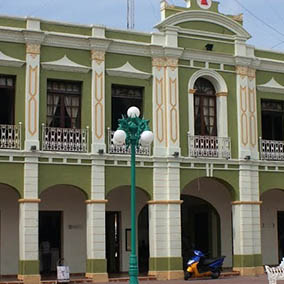At northern Veracruz state is one of the main oil-producing cities in Mexico—Poza Rica de Hidalgo, a perfect destination for business tourism and for those who want to know the Totonacapan region, as it borders the Pueblo Mágico (Magical Town) of Papantla and the Archaeological Site of Tajín.
Poza Rica adopted the name because, in the past, the first Totonac natives built their shacks on the banks of the now extinct stream “El Mollejón”, a backwater rich in fish, which they gave the nickname “Poza Rica”. Later, with the first oil well drilling, it was baptized as Ranchería de Poza Rica. It was until 1951 when the city was decreed and named Poza Rica de Hidalgo, in honor of the priest Miguel Hidalgo y Costilla.
Despite being an industrial city, Poza Rica has some attractions to visit in one day. For example, the only mural in fresco technique is in the center and belongs to the City Hall facade. Named “Desde las primitivas labores agrícolas prehispánicas hasta el actual desarrollo de la industria petrolera” (“From the primitive prehispanic agricultural work to the current development of the oil industry”) the work is a creation of the muralist and illustrator Pablo O'Higgins, who made a homage to Poza Rica history with his brush-strokes.
A few steps away, you can walk along the trails of Benito Juárez park and, in the afternoons, dance a good danzón or drink a coffee in one of the cafes that surround it. But if you still feel like dancing, then you have to go to 20 de Noviembre St, just three blocks away from the park, to continue the party in one of the bars or clubs located here. Among young people, the artery is known as “La Veinte” (The Twenty).
You should explore the Adolfo Ruíz Cortínez Blvd, as it concentrates important monuments of Poza Rica such as “La Maquinita”, an original Decauville locomotive, which at the time was used to communicate the city with the port of Tuxpan and later it would be the mean of transport for the families that invested in the oil industry.
The Reloj de la Paz (Clock of Peace) is a city icon. It was a symbol-of-gratitude gift for the welcome and warmth that the people of Veracruz had with the Chinese community settled in Poza Rica during the 1950s.
The piece was ordered to be made to the Pueblo Mágico (Magical Town) of Zacatlán de las Manzanas in Puebla, and is supported by a tower. There, locals usually celebrate any event in the public domain, such as soccer finals.
The same boulevard leads to Parque de las Américas, which serves as Poza Rica’s great viewpoint. From here you can see the Cazones river running through city streets.

